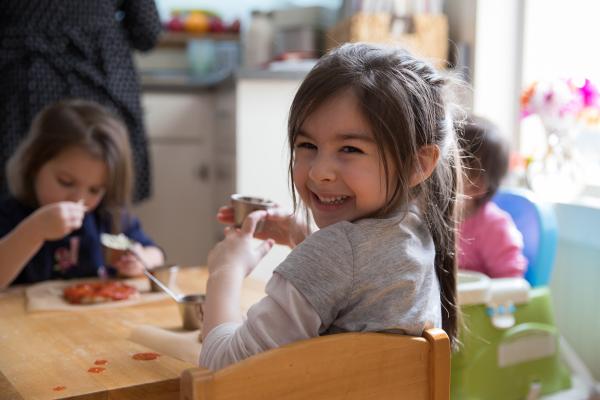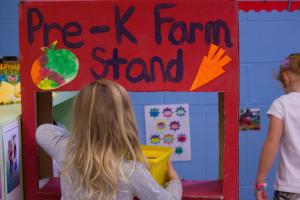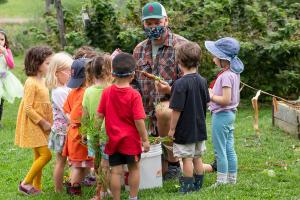Making Butter Activity, and the Power of Food Memories
When I ask adults these questions, many have an immediate, visceral response, whether it’s a fond memory…or a memory of something not so tasty. Early food associations are enduring, and when we’re young, we often eat with our eyes and nose way before we put a thing in our mouth. Food holds a lot of power, and it holds a lot of opportunity for us early childhood educators to help set attitudes for life.
What is Farm to Early Childhood?
Simply put, Farm to Early Childhood is all about engaging students in where their food comes from. In early childhood education, as soon as we talk about lunch, prepare a snack, or sit down for a meal beside our students in the classroom, we’re transitioning to being a food educator. And, if you’re planting gardens, baking bread, or doing some kind of nutrition activity in your classroom, you’re already engaged in this work.
Vermont FEED uses the Three C’s model to talk about Farm to School: cafeteria, classroom, and community. For those of us in early ed, the community element could be as simple as getting strawberries or squash from your local farmer’s market for your class to taste test, or writing to a local farmer pen pal. When you get all three going at once – cafeteria, classroom, and community – you’ve got a Farm to Early Childhood program.
There are a lot of reasons why Farm to Early Childhood is important. Farm to Early Childhood is shown to improve nutrition with our youngest children at a time when their brains (and tastes) are developing. It promotes local eating, supporting our local food systems. And, kids hold a lot of power in their families (I don’t know about you, but in my house, the two-year-old’s have a lot of power), so Farm to Early Childhood activities can ripple out to an entire family’s eating and purchasing habits. As educators, we have the ability to set the foundation for kids, and positively impact their lifelong relationship to food. We owe it to ourselves, and to the future, to offer these opportunities.
Activity: Shake it, Shake it, Shake it! (Buttermaking)
This activity, adopted from Cultivating Joy and Wonder, is a great way to add depth of learning to your classroom and to prompt conversations about where our food comes from. Follow the instructions below to make butter with your students.
Materials
- heavy cream, at room temperature (to speed its transformation into butter)
- a jar with a lid, capable of holding one cup of liquid
- small colander, a bowl, and butter knife
- soda crackers
Directions
- Discuss with children their ideas on how butter is made. Record their ideas.
- Gather your group into a circle, explaining that they will all need to help turn this heavy cream into butter. Heavy cream is the thick, fat-rich part of milk with a fat content of 36–40%. If fresh, unpasteurized milk is left to sit, cream rises to the top.
- Fill a small glass or plastic jar with ¾ cup of heavy cream. Make sure the lid is on tightly, and hold it with two hands as you begin to shake it up and down. After demonstrating how to shake, pass the jar around the circle.
- As the first person is shaking, ask everyone to shake their hands as you all sing the first verse of the Buttermaking Song (below). Pass the jar with each new verse.
- As each verse is sung, shake a different part of your body. Sing it louder, softer, sing it in the language of cows, sheep, pigs!
- Check the cream’s transformation occasionally by opening the lid. Pass it around so everyone can see that something is happening. The cream will thicken into a whipped-cream consistency, but it is not butter yet.
- After 5–10 minutes, listen for the sound of liquid sloshing in the jar. A pale, thin liquid—the buttermilk—will be surrounding the solid butter. Sing the final verse.
- Carefully pour the contents of the jar into the colander. As the buttermilk passes through, a beautiful lump of yellow butter will remain. Rinse the butter with cold water to remove all of the buttermilk if you plan to store it. This is not necessary if you plan to eat the butter immediately. The buttermilk can be reserved for use in baking.
- Spread the butter on crackers and eat. As you enjoy the butter, process and reflect on the experience with the children by engaging in a conversation guided by the discussion questions.
Discussion Questions
- What did you expect would happen to the cream before we started?
- What happened to the cream?
- Can you think of anything else that changes from a liquid to a solid? Or a solid to a liquid?
Short on time? You can stop once you’ve made whipped cream! Here are the steps for making whipped cream – and, watch this video to see our staff singing the buttermaking song.
Buttermaking Song
Sung to the tune of “I Have Something in My Pocket”
Chorus:
Shake it, shake it, shake it
Shake it all you can
Shake it like a milkshake
And pass it to a friend!
Verses:
We’re going to make some butter
Rich and creamy, too
With milk from a cow’s udder
Before you can say moo
Put some cream into a jar
Bring a friend or two
Make sure the lid’s on tightly
That’s all you have to do
We’re learning while we’re churning
Hey this is lots of fun
It’s easy to make butter
Let’s eat it when it’s done
Oh, listen very carefully
It’s sounding different now
Hooray! It’s finally butter
Be sure to thank a cow!
There are more activities for early childhood educators in Shelburne Farms’ “Cultivating Joy and Wonder.” Find this and other resources to download, and read more about growing farm to early childhood programs on the VT FEED website.
The Farm to Early Childhood in the Kitchen Workshop Series kicks off today, January 13 with classes for educators running through Feburary. Visit our educator workshops page to see upcoming programming.



